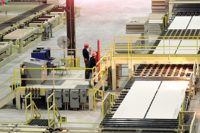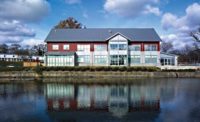In New Bern, North Carolina, history is coming to life—and history is being made—at the North Carolina History Center at Tryon Palace. For Rockfon, the project’s special challenges required solutions that broke new ground in custom ceiling panel fabrication.
The site selected for the new history center was the site of the former Barbour Boat Works warehouse located on the Trent River. The building featured massive steel trusses spanning the width of the building and other architectural elements typical of 19th century industrial style.
Many features of the new, 60,000 square-foot history center were inspired by these design elements. By its very nature, the goal of the history center was to connect the past with the present. But the architectural design had to do more. The objective was to create a design that reflected the history of the town and industrial character of the waterfront site, while pioneering new ideas in sustainable building design.
Two architectural firms took on the challenge: BJAC in Raleigh, N.C. and Quinn Evans in Georgetown, D.C. The building’s sustainability goals were achieved in multiple ways, ranging from permeable surface parking areas and a constructed wetlands to energy-efficient operations and maintenance.
According to Jennifer Amster, principal at BJAC, “We chose [Rockfon] Planostile panels for the ceilings in many areas because they have 75 – 100 percent recycled content and are 100 percent recyclable. That contributed to our sustainability objective, and helped elevate the ceiling system from one that delivered not only beauty and acoustic performance, but environmental benefits as well.”
To maintain the historic integrity of the building, the architects modeled the design of the steel trusses and exposed masonry on original architectural elements found in the area. Then, they added modern metal and glass to allow views to the river from the central gathering spaces and create a contemporary atmosphere.
Amster notes that, “Because we retained the building’s 19th century structural base, it was important that all other interior building elements fit within that structure. That presented some challenges for our suppliers and contractors.”
For Rockfon, doing so required a unique approach to ceiling panel fabrication.
A Challenge of Historic Proportions
A unique ceiling system consisting of floating clouds of acoustic panels was specified to soften the noise in the history center’s Great Hall and other expansive public spaces. Rockfon Planostile Snap-in perforated metal ceiling panels were chosen. The challenge came in customizing the panel sizes and shapes to align precisely with other architectural features of the building.
“This was one of the most complex systems I’ve ever seen,” noted Bill Barlow, business development manager at Acousti Engineering Co., the ceiling installer. “Ceiling clouds and panel reveals had to align precisely with adjacent architectural features. There were clouds within clouds, and panels had to be cut in multiple sizes and dimensions.”
In all, the design required 34 different ceiling panel sizes, in four different colors. Adding to the challenge was the fact that the architect had specified that there be no field cutting of panels.
According to Rockfon Project Manager Dave Jahn, “They wanted to use full panels to assure a true flat finish was achieved when installed. This meant that in addition to adapting our suspension system to the building design, we had to engineer the precise size of each panel so that it installed perfectly out of the box.”
To do so, Rockfon worked with the architect and installer to nail down exact measurements. Then, over a period of three months, shop drawings were created, revised and refined to assure that each panel was fabricated in the right dimensions.
Pioneering Packaging
With so many different ceiling panel sizes and colors to be installed, finding the right pieces to the puzzle on site could have created time-consuming complications. Dave Jahn and the Rockfon team were proactive in preventing this scenario. A special packaging system was created that clearly showed which box was for what section of the installation. Inside the boxes, installers found shop drawings and fabrication schedules.
“We even labeled each panel with a part number that matched the drawings,” noted Jahn. “We tried to eliminate every potential problem and make the ceiling system highly user friendly for the installer.”
A Perfect Fit
In the end, what could have been a highly problematic installation was simplified by advance planning and a focus on precise measurement and fabrication.
“There was an enormous potential for complications with this job. We were on a tight installation schedule and this custom system required a great deal of coordination with the MEP trades,” said installer Bill Barlow. “[Rockfon] did a tremendous job. Not one panel was improperly sized.”
| PROJECT |
North Carolina History Center at Tryon Palace—New Bern, NC |
| ARCHITECTS |
Jennifer Amster, BJAC—Raleigh, NC Quinn Evans—Georgetown, D.C. |
| INSTALLER | Bill Barlow, Acousti Engineering Co.—Raleigh, NC |
| ROCKFON PRODUCTS |
Rockfon Planostile Snap-in Metal Ceiling Panels Rockfon Infinity Perimeter Trim Chicago Metallic 15/16 1200 Seismic Suspension |












Report Abusive Comment